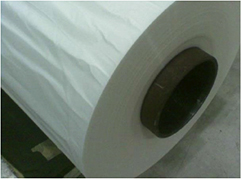Web Lines | Action Plan for CD Buckles, Part 1
- Published: March 06, 2017, By Tim Walker
Cross direction buckling defects have many names, but they all share one common mechanism.
 Cross direction (CD) buckles are a wound roll defect featuring crossweb ridges or corrugations running widthwise across a roll. They may form throughout a roll, but are more likely to form near the core or in lanes of below-average thickness.
Cross direction (CD) buckles are a wound roll defect featuring crossweb ridges or corrugations running widthwise across a roll. They may form throughout a roll, but are more likely to form near the core or in lanes of below-average thickness.
CD buckles may become permanent deformations in the web and create functional or optical defects in final products, especially in laminated or coated products. In Part 1 of this three-part series, we’ll look at the common causes of these types of defects.
Also Known As…
 CD buckling defects have many names, including core buckles, starring, spoking, corrugations, crossbuckles, washboarding, softbands, gapping, and peaking. CD buckles occurring near the core that radiate in small or large triangular patterns are usually called starring or spoking defects.
CD buckling defects have many names, including core buckles, starring, spoking, corrugations, crossbuckles, washboarding, softbands, gapping, and peaking. CD buckles occurring near the core that radiate in small or large triangular patterns are usually called starring or spoking defects.
Starring is a paper industry term in which the buckled layers in rolls of thicker papers may form two or more large triangular-shaped patterns that may radiate 2–20 in. from the core. Spoking is a film industry term in which the buckled layers in rolls of thinner films will form 10–100 narrow spike-like patterns that usually only radiate 0.25–1 in. from the core.
DEFECT MECHANISM
CD buckles form from several causes, but all CD buckles share one common mechanism—layers within a roll are under machine direction (MD) compressive stresses and strain. Any solution to CD buckles should consider two factors:
- What tension or strain did the buckling layers have when they joined the winding roll?
- What tension or strain was lost in subsequent winding or roll storage?
The MD tensions and strains of layers within a roll are the difference between the initial tension created by the winder as the layer joins the winding roll and the change in tension or strain as additional layers are added to the roll or during roll handling and storage. Tensions rarely increase over time. Any layer that loses more strain than it started with will be in compression.
Webs are poor at supporting compression. The friction-bonded “laminate” of a winding roll’s layers will take more to buckle than an unsupported single layer (e.g., a span between rollers), but at a low level of compression, layers will form CD buckles. Buckling can seem somewhat random, forming in a subset of rolls wound at “the same” conditions, but buckling is often initiated by the defect or discontinuity of winding variations, such as thickness profile, alignment, tape, or wrinkling.
CD buckles are usually considered a “soft” roll or low tension defect, but they also can be caused by too high of tension or changing tension from low to high. (Winding tension is the combination of torque, nipping, and tension taper).
Too much tension causing CD buckles is strongly tied to core stiffness or collapse. Winding many layers onto a core can create high pressures, enough to significantly compress the core or cause the core to buckle. If core compression exceeds the web strain of the near core layers, CD buckles may form.
High pressure and core compression is more common with:
- High winding torque or nip load
- Stretchy, stiff stack, and thin webs
- Small cores and large buildup ratios
- Low speed winding of smooth, non-porous webs
- Thick profile lanes
Too low of tension is the more common cause of CD buckles. Layers wound with low tension form into layers that have low initial strain and easily lose that strain when more layers are wound atop them.
Low pressure and roll layer compression is more common with:
- Low winding torque or nip load
- Stiff, soft stack, and thick webs
- Large cores and small buildup ratios
- High speed winding of smooth, non-porous webs
- Thin profile lanes
The worst combination is to start a roll with low tension and then wind higher tension layers atop the low tension layers by significant increases in torque or nip load. This is described as winding “hard” on top of “soft” and should be strongly avoided in all winding.
In Part 2 and Part 3 of this series, we’ll look at remedies for these CD buckling defects, starting at the core and moving forward.
Web handling expert Tim Walker, president of TJWalker+Assoc., has 25 years of experience in web processes, education, development, and production problem solving. Contact him at 651-686-5400; tjwalker@tjwa.com; www.webhandling.com.












